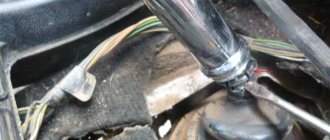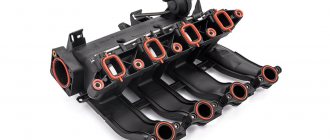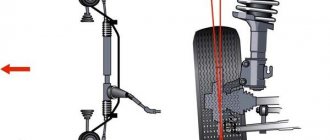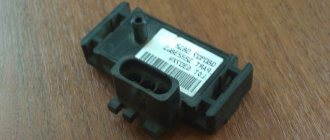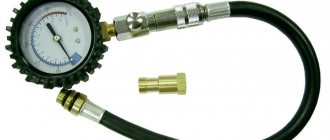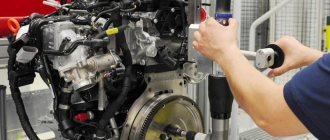How to check compression in cylinders with your own hands
The pressure in an engine cylinder is a meaningless number for an amateur or amateur. An experienced auto mechanic, having measured the pressure in the engine cylinders, will determine with fairly accurate parameters the degree of malfunction and wear of parts of the valve mechanism and connecting rod-piston group of the engine.
Let's start with the fact that compression testing should be carried out in several cases. Your engine power has dropped, you have carried out a major overhaul of the cylinder block or repair of the cylinder head, which means checking the compression in the cylinders is a sacred matter. In the first case, the compression in the cylinders is checked necessarily, and in the second for control.
How to check the pressure in an engine cylinder
Taking into account the fact that you do not run a service station, you need a compression gauge. Modern samples of compression meters are equipped with the latest technology. The kit includes adapters (adapters) that allow you to check compression in engine cylinders on cars of any make (model).
Motor testers and compressors, in fact, should not interest you. These are devices for commercial use in car repair shops.
In addition to the device, you will need a manual specifically for your engine type, which shows the parameters of standard compression values.
How to check the compression of a gasoline engine?
Checking compression in a gasoline engine is carried out using a compression gauge. Before checking engine compression, you need to make sure that the valve clearances are set correctly; adjust if necessary. Before checking the compression, the engine is warmed up to operating temperature (~90 degrees), after which the spark plugs are removed and the air damper is opened. The air damper can also be opened by pressing the gas pedal all the way.
Insert the compression gauge into the spark plug hole and press firmly. At this moment, the second person must squeeze the gas all the way (if the throttle is not pulled back) and turn the ignition key. It is necessary to turn the starter until pressure stops building up on the compression gauge. After checking one spark plug hole, move on to the other, resetting the data from the device (don’t forget to write it down).
Before checking the compression, you need to make sure that the battery is reliable; it must create a crankshaft rotation of at least 180 rpm, otherwise there will be an error when measuring compression.
Related post: Non-alcoholic beer while driving
If you were able to successfully check the compression and the values in each of the cylinders exceed 10 points, then there is no need to worry. However, for some engines, 12 points may be considered normal compression. You can find out the required compression for your engine in a car repair book. Please note that the difference between the compression in the cylinders should not exceed 1 kg/cm2, otherwise the engine will run unevenly.
Reduced compression in the cylinders may be due to worn piston rings or loose valve seats. If compression is reduced in all cylinders, then in this case it is necessary to completely replace the piston rings.
In order to more accurately determine why the compression has decreased, you can take a 20 cc syringe with oil and pour it into the problem cylinder, after which you need to measure the compression again. If the compression remains unchanged, then the problem is that the valves do not fit tightly to the seats, or it may be unlikely that the cylinder head gasket is damaged. If, after measuring compression with oil, it increases, then the problem is definitely in the piston rings.
Related post: How to remove scratches on a car
There are situations when the owner of the car does not change the oil for a long time or uses low-quality oil. In this case, the piston rings could simply become coked. Decarbonization can solve this problem; it doesn’t cost much and works very quickly and effectively. The candles are unscrewed and liquid is poured into the holes in equal quantities. More decarbonizing agent must be poured into problem cylinders. Wait 30-60 minutes, crank the engine thoroughly with the spark plugs turned out and change the engine oil, since all the decarbonization flows into the pan. If after this manipulation the compression returns, then you don’t have to worry and start using higher quality oil.
That's all, we hope you now understand how to check compression and determine the malfunction.
2013-06-24
admin
Checking compression in cylinders yourself
The procedure and rules for checking compression in the cylinders of any car manually are, in principle, no different.
- checking compression in the cylinders is carried out on a “warm” engine;
- first turn off the fuel supply to the engine (turn off the fuel pump, injectors);
- Let's turn everything out! Candles, and not selectively, as some would-be masters practice;
- a prerequisite is a fully charged battery and a working starter;
- The compression test can be carried out both with the throttle valve open and with the throttle valve closed. Each of these methods will show different results of the engine condition. When the damper is open, defects such as: piston burnout, coking of rings, burnouts or deformation of valves and scuffing on the surface of the cylinders are quickly determined; When the damper is closed, a change in the compression level most often indicates engine malfunctions such as: valve sticking, leakage due to a crack in the wall of the combustion chamber or burnout of the cylinder head gasket;
- We begin to check the pressure in the engine cylinder, one by one. Using the starter, crank the crankshaft until the pressure stops increasing. We record the testimony. We reset and do the same with all cylinders.
Checking compression (pressure) in car engine cylinders
The content of the article:
Good day, dear motorists! What attracts us when choosing a car, and what do we pay attention to first of all?
Absolutely right! Engine power. And if your car’s engine power suddenly begins to noticeably drop, or, even worse, the engine becomes difficult to start, you need initial engine diagnostics.
And any motorist, without exception, can check the pressure in the engine cylinder. This is the so-called cylinder compression test.
What is engine compression and why is it needed?
Determination of compression in engine cylinders
Engine compression is a value that determines the air pressure in the engine cylinders at the end point of the compression stroke, at the moment the crankshaft is rotated by the starter. Checking engine compression allows you to more or less accurately diagnose problems in the engine, without disassembling it. A decrease in compression can occur for various reasons.
This includes wear of piston group parts, malfunction of timing parts (gas distribution mechanism), and... listing the reasons can take more than one page. In any case, a decrease in pressure worsens engine parameters and efficiency.
For a car enthusiast, the numbers obtained by measuring the pressure in an engine cylinder are unlikely to be clear. But that’s why there are Guides and recommendations for measuring engine compression.
A device for checking compression is called a compression meter. A compression tester is the most effective device for checking compression in cylinders, suitable for amateur use.
Modern samples of compression meters are “packaged” specifically for the consumer. They are equipped with adapters for different engine models. To measure engine compression, car service centers use motor testers or compression meters, but we are not interested in them.
Important! In order to know the original standard cylinder compression figures determined by the manufacturer, you will need a manual specifically for your engine type.
The average compression figure for a serviceable gasoline engine is 9.5 - 10 atm. The spread of values across the engine cylinders should not exceed 0.5 - 1 atm.
How to check engine compression
For any engine, when checking the pressure in the cylinders, the technological procedure is similar. The main condition is that before starting a compression test, you need to fully charge the battery and be sure that the starter is working.
- We carry out a compression check with the engine warmed up to operating temperature (80-900C). In this case, a minimum viscosity of the engine oil is achieved, and the gaps between the moving parts of the piston group are reduced;
- disable the possibility of supplying fuel to the engine;
- If starting the engine is difficult, then check the pressure on a cold engine. Wear of piston group parts or “sticking” of rings can cause compression to be reduced by half;
- unscrew all the spark plugs, open the air damper and throttle fully (or check with the throttle closed);
- the tip of the compression gauge is inserted into the hole for the spark plug of the first cylinder (this is where knowledge of the cylinder numbering order comes in handy). Using the starter, we begin to turn the crankshaft until the pressure in the cylinder stops increasing.
- Having recorded the instrument readings, we reset them and carry out similar operations with the remaining cylinders.
What malfunctions does the engine compression test show?
- The dynamics of compression growth suggests that if during the first compression stroke the pressure is low 3-4 atm, and then increases upward, for example up to 8 atm, then the reason may be: wear of rings, piston grooves, cylinder walls;
- Compression does not increase, this indicates that air is escaping through damage to parts (valve seats) of the cylinder head;
- When the damper is fully open, a change in compression parameters indicates such malfunctions as: scuffing on the surface of the engine cylinders, deformation of the valves, burnout of the valves or piston, coking of the rings, etc.;
- When the damper is closed, a change in compression may indicate cracks in the wall of the combustion chamber, burnout of the cylinder head gasket, stuck valves, etc.
The causes of low compression can be identified using “folk” methods
Pour 25 cm3 of engine oil into the low compression cylinder and check the pressure in this cylinder again. The amount of compression remained the same; we can say with almost one hundred percent certainty that the cylinder head gasket is damaged or the valves do not fit tightly to the seats. An increase in pressure compared to the first indicator indicates wear of the piston rings.
Using a compressor, we supply compressed air to the cylinder by placing a conical tip from a compression meter on the compressor hose. The piston, before supplying air to the cylinder, is set to DVN/air pressure 2.5-3 kg/cm. Move the gearshift lever into high gear and lock the hand (parking) brake to prevent crankshaft rotation.
Air escaping through the carburetor indicates that the intake valve is not seating tightly. Air escapes into the adjacent cylinder or through the radiator (determined by air bubbles at the neck) - the cylinder head gasket is damaged.
In any case, if, when checking engine compression, the device shows significant deviations or changes in parameters from those specified by the manufacturer, then a more comprehensive and thorough diagnosis is required.
Although, it is already clear that engine repair cannot be avoided. And already during disassembly of the cylinder head, you can more accurately draw a conclusion about the repair or replacement of a particular part. The compression check fulfilled its mission - it pointed to the approximate direction of troubleshooting the engine.
Good luck with your compression test.



